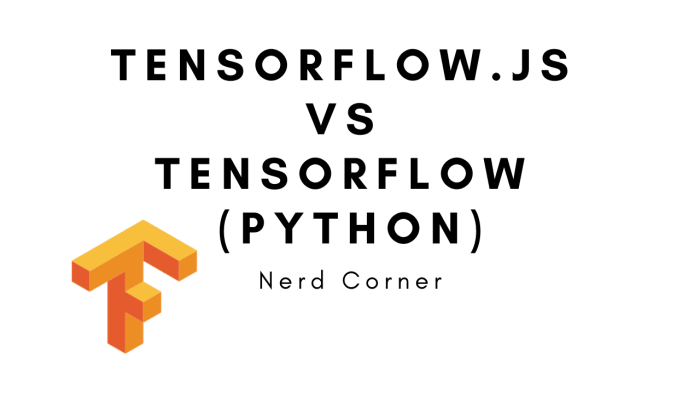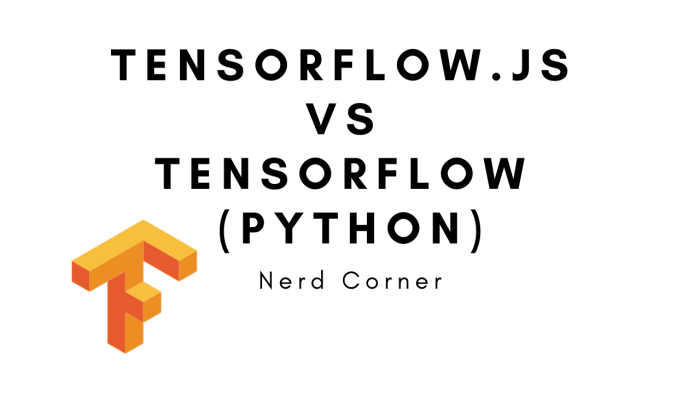Why TensorFlow for Python is Dying a Slow Death: The world of deep learning is in constant flux, and while TensorFlow once reigned supreme, its dominance is being challenged. A new contender, PyTorch, has emerged, captivating the deep learning community with its flexibility and ease of use.
This shift in favor of PyTorch is leading many to wonder if TensorFlow’s reign is coming to an end.
The rise of PyTorch can be attributed to several key factors. Its dynamic computational graph, which allows for on-the-fly changes, makes it incredibly versatile for research and experimentation. PyTorch’s intuitive Pythonic syntax makes it easier for developers to learn and use, while its strong community support ensures ample resources and guidance.
These advantages, coupled with TensorFlow’s perceived complexity and steep learning curve, have created a compelling argument for switching to PyTorch.
Rise of Alternatives
The decline of TensorFlow in Python is not solely due to its shortcomings but also to the rise of alternative deep learning frameworks, particularly PyTorch. PyTorch has gained immense popularity among researchers and developers, challenging TensorFlow’s dominance in the field.
PyTorch’s Growing Popularity
PyTorch’s popularity is a testament to its compelling features and advantages. It offers a dynamic computational graph, a user-friendly interface, and strong support for research and development.
- Dynamic Computational Graph:PyTorch’s dynamic computational graph allows for flexibility in defining and modifying the model structure during runtime. This dynamic nature makes it ideal for research and experimentation, where models often evolve iteratively.
- User-Friendly Interface:PyTorch’s intuitive API and Pythonic design make it easy to learn and use, even for beginners.
Examine how synthetic data safe low cost alternative data can boost performance in your area.
Its seamless integration with Python’s ecosystem further enhances its usability.
- Strong Research Support:PyTorch has become the framework of choice for many research labs and universities. Its active community, extensive documentation, and readily available resources contribute to its popularity among researchers.
Comparison of Design Philosophies
The design philosophies of PyTorch and TensorFlow differ significantly, impacting their strengths and weaknesses.
- TensorFlow:TensorFlow emphasizes static computational graphs, which are defined before execution. This approach is well-suited for production environments, where efficiency and performance are paramount. However, it can hinder experimentation and model development due to its static nature.
- PyTorch:PyTorch adopts a dynamic computational graph approach, allowing for on-the-fly modifications during execution.
This flexibility makes it ideal for research and prototyping, where experimentation and rapid iteration are essential.
Comparison of Functionalities
While both frameworks offer core functionalities for deep learning, their specific features and capabilities differ.
- TensorFlow:TensorFlow excels in large-scale deployments and production environments. Its robust infrastructure and tools for distributed training and model optimization make it suitable for handling massive datasets and complex models.
- PyTorch:PyTorch shines in research and development. Its dynamic nature, ease of use, and active community make it a popular choice for experimentation, prototyping, and building novel deep learning models.
TensorFlow’s Complexity and Steep Learning Curve
TensorFlow’s reputation for complexity and a steep learning curve is a significant factor contributing to its decline in popularity. While its power and flexibility are undeniable, these advantages come at the cost of a learning experience that can be daunting for beginners and even experienced developers unfamiliar with its intricate structure.
TensorFlow’s Complexity
TensorFlow’s complexity stems from several key factors:
- Graph-Based Computation:TensorFlow’s core concept revolves around building computational graphs, where operations are represented as nodes and data flows between them. This approach, while powerful, requires a different way of thinking about programming compared to traditional imperative languages. Beginners often struggle to grasp the concept of building and executing these graphs, especially when dealing with complex models.
- Session Management:TensorFlow’s session management adds another layer of complexity. Sessions are responsible for executing the computational graph and managing resources. Understanding how to create, manage, and close sessions is crucial for efficient TensorFlow usage, but it can be confusing for beginners.
- Low-Level API:TensorFlow’s low-level API provides granular control over every aspect of the computation process, allowing for maximum flexibility. However, this level of control also makes it more challenging to learn and use effectively. The sheer number of functions and classes can be overwhelming for newcomers.
- Eager Execution:While TensorFlow has introduced eager execution, which simplifies development by allowing for immediate execution of code, the underlying graph structure still exists. This can lead to confusion, especially when transitioning between eager and graph modes.
TensorFlow’s Learning Curve, Why tensorflow for python is dying a slow death
The learning curve for TensorFlow can be steep for several reasons:
- Abstraction Gap:TensorFlow’s abstraction gap between the high-level API (Keras) and the low-level API (TensorFlow Core) can be confusing. Beginners often struggle to understand the relationship between these layers and how to effectively use them.
- Limited Resources:While TensorFlow offers extensive documentation and tutorials, they can be overwhelming for beginners. The sheer volume of information and the lack of clear pathways for learning can make it challenging to navigate.
- Lack of Intuitive Examples:TensorFlow’s examples, while comprehensive, can be complex and lack the simplicity needed for beginners to grasp core concepts. This can make it difficult to relate the theory to practical applications.
- Debugging Challenges:Debugging TensorFlow code can be a frustrating experience. The graph-based structure and the asynchronous nature of TensorFlow’s execution can make it difficult to pinpoint errors.
Examples of Cumbersome Syntax
Here are some examples of how TensorFlow’s syntax can be cumbersome compared to alternatives:
- Defining a Simple Linear Regression Model:In TensorFlow, defining a simple linear regression model requires several lines of code, including defining placeholders, variables, operations, and a session. In contrast, libraries like PyTorch allow for a more concise and intuitive definition.
- Data Loading and Preprocessing:TensorFlow’s data loading and preprocessing mechanisms can be verbose and complex. Libraries like scikit-learn offer more streamlined and efficient methods for handling data.
Evolving Deep Learning Landscape

The deep learning landscape is undergoing a rapid transformation, shifting away from monolithic frameworks towards a more dynamic and research-oriented approach. This shift is driven by the increasing complexity of deep learning models and the need for greater flexibility in research and experimentation.
Frameworks for Research and Experimentation
The focus on research and experimentation is driving the development of new deep learning frameworks that prioritize flexibility, modularity, and ease of use. These frameworks are designed to facilitate rapid prototyping, experimentation with novel architectures, and exploration of new ideas.
This emphasis on research is leading to a growing demand for frameworks that can handle the complexities of cutting-edge deep learning models and support the iterative nature of research.
“The deep learning landscape is evolving rapidly, with a growing emphasis on frameworks that facilitate research and experimentation.”
Industry Adoption and Real-World Use Cases: Why Tensorflow For Python Is Dying A Slow Death
The industry adoption rates of TensorFlow and PyTorch are a critical factor in determining the future of these deep learning frameworks. While TensorFlow initially dominated the landscape, PyTorch has gained significant traction, particularly in research and academia, leading to a shift in industry preference.
Industry Adoption Rates
TensorFlow and PyTorch have distinct strengths and weaknesses, influencing their adoption in various industries. TensorFlow’s initial advantage in production-level deployments and its extensive ecosystem have made it popular in companies with large-scale infrastructure and established workflows. However, PyTorch’s ease of use and flexibility have attracted researchers and startups, leading to its rapid adoption in research and development.
- TensorFlowis widely used in companies like Google, Amazon, and Uber, where its scalability and production-ready tools are highly valued. It is prevalent in industries such as:
- Search engines: TensorFlow powers Google Search, enabling efficient text processing and understanding.
- Image recognition: TensorFlow is used in image recognition applications, including facial recognition and object detection, deployed in various industries, including security and surveillance.
- Natural language processing: TensorFlow’s language models are used in various applications, including machine translation, sentiment analysis, and chatbot development.
- PyTorchhas gained popularity in research and startups, where its ease of use and flexibility are highly valued. It is particularly popular in:
- Computer vision: PyTorch is widely used in computer vision research and development, powering applications such as image classification, object detection, and image segmentation.
- Natural language processing: PyTorch is increasingly used in NLP research, enabling the development of advanced language models and applications.
- Robotics: PyTorch’s flexibility and integration with other robotics libraries make it a popular choice for robotics research and development.
Real-World Use Cases
The growing adoption of PyTorch is evident in its use in various real-world projects and applications.
- OpenAI’s GPT-3: This powerful language model, trained using PyTorch, demonstrates the framework’s capabilities in generating human-quality text, translating languages, and writing different kinds of creative content.
- Facebook’s AI Research (FAIR): FAIR utilizes PyTorch extensively for its research projects, including object detection, image segmentation, and natural language understanding.
- NVIDIA’s Clara platform: This platform, built on PyTorch, provides tools and resources for developing AI-powered healthcare applications, including medical imaging analysis and drug discovery.
Future of TensorFlow
TensorFlow, despite facing challenges, is not fading away. Instead, it’s evolving and adapting to the ever-changing landscape of deep learning. Google, the company behind TensorFlow, is actively working on enhancing its capabilities and addressing its shortcomings.
TensorFlow’s Future Directions
TensorFlow’s future is marked by a strategic focus on addressing its limitations and expanding its reach. These efforts aim to ensure its continued relevance and dominance in the deep learning ecosystem.
- Enhanced User Experience:TensorFlow is actively simplifying its API and improving its user experience. The goal is to make it more accessible to a wider range of developers, including those with less experience in deep learning. This includes initiatives like the development of TensorFlow Lite for mobile and embedded devices, and TensorFlow.js for web applications.
- Improved Performance:TensorFlow is constantly being optimized for better performance. This involves advancements in hardware acceleration, distributed training, and model compression techniques. The focus is on achieving faster training times, lower latency, and reduced memory consumption.
- Focus on Research and Innovation:TensorFlow remains at the forefront of deep learning research. It continues to introduce new features and functionalities, like support for quantum computing and federated learning, to cater to the latest advancements in the field.
- Ecosystem Expansion:TensorFlow is expanding its ecosystem to encompass a wider range of applications and tools. This includes integrations with other popular platforms and frameworks, like Kubernetes and Apache Spark, for easier deployment and scaling of deep learning models.
Impact of Changes
These changes are expected to have a significant impact on TensorFlow’s long-term viability. By addressing its shortcomings and expanding its reach, TensorFlow aims to maintain its position as a leading deep learning framework.
- Increased Accessibility:The simplified API and improved user experience will attract a broader range of developers, contributing to a more vibrant and active community.
- Enhanced Performance:The focus on performance optimization will make TensorFlow more attractive for real-world applications that require speed, efficiency, and scalability.
- Innovation and Advancements:Continued research and innovation will ensure TensorFlow remains at the cutting edge of deep learning, driving the development of new technologies and applications.
- Stronger Ecosystem:The expanded ecosystem will provide developers with a more comprehensive and integrated platform for building, deploying, and managing deep learning models.


